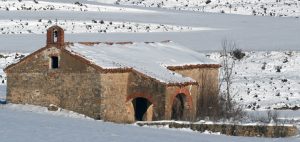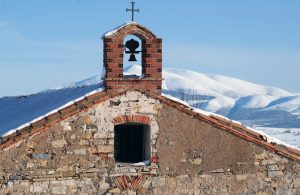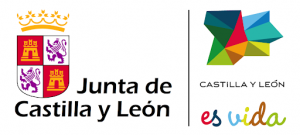Construida en las afueras de la población, es un claro ejemplo de la arquitectura religiosa rural. Responde a las inquietudes sociales y espirituales del momento porque está dedicada a los santos Roque y Sebastián, abogados contra la peste, bajo cuya intercesión se encomienda el pueblo para evitar o liberarse de las terribles epidemias del pasado. Aunque la veneración conjunta de los dos santos viene desde la Edad Media, es a partir del s. XVII cuando se desarrolla su culto. La construcción de la ermita de Valdelagua podemos situarla hacia la mitad del siglo XVIII.
De una sola nave y cabecera plana, tiene la puerta de entrada en el muro sur, protegida de las frecuentes inclemencias de la zona por un simple pórtico. El interior es de una sola nave, cubierta a dos aguas. Un arco de triunfo da acceso al presbiterio, de bóveda rebajada y con todo el zócalo pintado. El retablo del altar mayor se enmarca en un gran cortinón pintado, a modo de trampantojo, tan del gusto teatral del barroco.
El retablo, (hoy visible en la iglesia del pueblo), dentro de su aparente simpleza, es una pieza muy singular y representativa de las características estéticas del barroco: tensión, por la doble titularidad de su dedicación; teatralidad, porque se enmarca con una gran cortina desplegada que hace las veces del telón de un teatro; profusión decorativa, exhibida con abundancia en palmetas, róleos, onduladas hojas de acanto, cabecillas de angelotes, sin que falten las necesarias columnas salomónicas festoneadas de flores y frutos; clasicismo y dramatismo, en las excelentes tallas de los dos titulares, modeladas con gran estudio de las anatomías y la expresividad de cuerpos y rostros; dinamismo, en el plegado de los paños y contraposto de San Roque o en la curva serpentinata que dibuja el cuerpo de San Sebastián.
En definitiva, se trata de un retablo bastante excepcional por su advocación dúplice, que se puede datar a mediados del s. XVIII, encargado, (como la construcción de la ermita), para protección espiritual contra las pestes; de dimensiones modestas pero con un rico despliegue del aparato decorativo, de gran imaginación y factura notable, destaca el colorido general por la intensidad de su gama cromática, hoy algo deslucida por el paso del tiempo, sobresaliendo del conjunto las imágenes de los santos titulares, realizadas por un escultor de grandes dotes artísticas, clasicistas pero llenas de movimiento y posiblemente anteriores al retablo, en las cuales el estilo barroco alcanza su más alta expresión.





